Trip to Curacao and Bonaire 27 May through 24 June 2003
Curacao is the largest
of the Netherlands Antilles, with a population of about 150,000, 80% black descended
from the freed slaves of the Dutch plantations. The official language is Dutch,
which is what is taught in school, but about 90% of the whole population speaks
a dialext called Papiamentu, which is a combination of Portuguese, Dutch, and
some African words. We should have learned it before we went, because English
was by no means universal. I got by OK in Spanish, and Marc and Shea used me
for an interpreter. The industries are shipping, tourism and refining gas for
Venezuela, and they need to get much better at tourism.
Curacao--the view
we woke up to at AllWest Apartments

And the view that
night
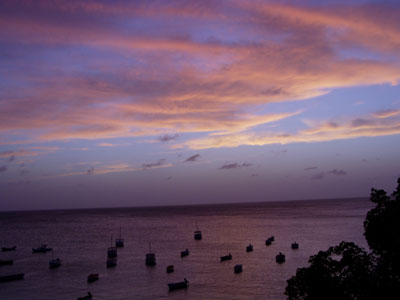
Local fisherman
hunting the elusive masbangu, which apparently comes out only in June. It's
a small silver fish caught in nets, which the whole family sets out at night
and the whole family gathers up again at dawn, with much shouting of, "Wada
wada wada!" which means, "Wait wait wait!". We naturally called
this the wada wada fish. It's fried whole, and eaten the same way. I have no
idea what one looks like, except we saw large schools of something that looked
like large minnows near the pier that afternoon

The waterfront in
Willemstad, capital city of Curacao. Dutch architecture with Caribbean colors
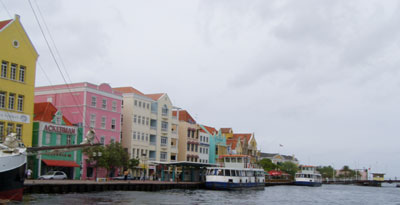
Marc and Shea at
a street cafe, Plein Cafe Wilhelmina
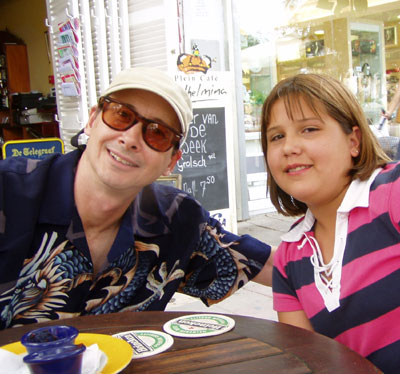
Kabritu Stew on
the hoof, or, The Goats of Curacao (they were everywhere)

A very pretty spot on the Western
Route

But most of the
island looked like this (Western Route overlooking St. Willibrordus)

Which is not to
say it wasn't pretty (Playa Lagun)

And another view
(Santa Margherita Baai)

We had the most
fun with the birds (well, after the fish). These flamingos were most
annoyed with the brown pelican

Every morning we
woke up to trupials, a kind of oriole. Maybe it's because we fed them? They're
all puffed up because they're fighting over the banana. (Doesn't it look like
the bluebird in Shrek just before it pops?)

We also had two
other types of birds who ate sugar and bananas (thanks for the tip, OC!), a
yellow oriole and a bananquit, which is a kind of finch. The trupials were the
largest, though. Maybe 12" long, tip to tail

We visited Hanchi
Snoa Synagogue, the oldest continuously used synagogue in the Western
Hemisphere. Built in 1732. The floor is covered with sand, to commemorate when
Jews had to have their religious meetings in secret, because of the Spanish
Inquisition. A beautiful and serene place. Curacao, BTW, is totally religiously
tolerant. Catholics, Jews, Muslims, Sikhs, Hindus, Voodoo, you name it, they
co-exist. We saw 'em all.
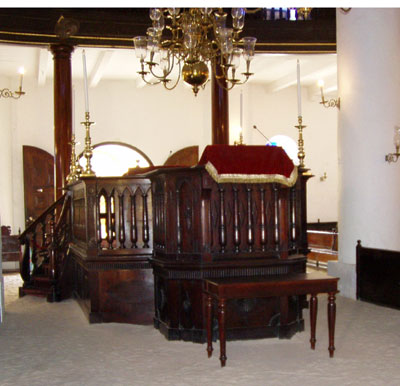
And we leave Curacao,
headed for Bonaire. Good night!

Bonaire is the smallest of the Netherlands
Antilles, after Aruba. It was beautiful and friendly. Its main industries are
tourism and sea salt production.
Here is one of the
salt pans. They actually are this color, and the pink bacteria gets into the
brine shrimp and makes the flamingos pink when they feed in the pans.

In the old days,
these pans were worked by about 100 slaves, who lived in small huts and then
went home to their families on the weekends in the interior of the island. (That's
all the slavery that ever was on this island, and it's much happier than Curacao
for having little plantation background)

There were birds
all over this island too, mostly flamingos. It is one of the 5 breeding grounds
in the world for them. They were around every turn and bend in the road, wherever
there was water, but largely in salinas or salty lakes.

Typical Bonaire street scene, Divi
Divi tree and goat. You can always tell which way is west, because that's the
way the divi trees point

Traffic jam in Rincon

Another typical scene, divi trees and donkeys. There
are about 500 wild donkeys on the island, and they cause traffic jams, eat gardens,
and are generally a nuisance

For some reason,
the donkeys all loved Shea's shoes!

We went to Washington-Slagbaai
National Park, which had this interesting scene at a watering hole. Guess you
can't pick your friends

They like people
too - because visitors feed them

Shea decided to
retreat and let this one have the rock she was sitting on (especially because
reinforcements were arriving for its side!)

Up close and personal
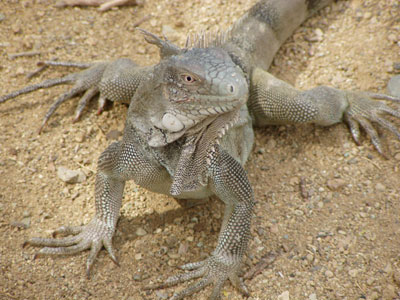
Too close...a little
too close!

The wind blows around
15 knots day in and day out, 365 days a year. This is the windward side, and
as you can see, no one swims here

The obligatory island hairdo...someone
had to do it, and mine was way too short!
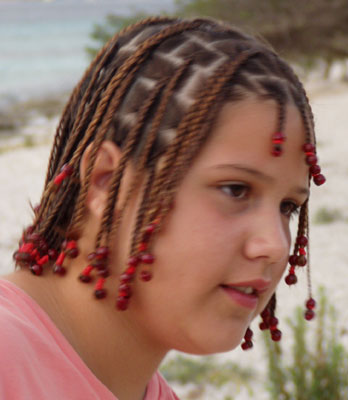
And now we leave Bonaire...I hope
to come back someday soon and stay longer. It's a quiet place, but we loved
it!

It was like a gateway to another
time...

(Couldn't help myself.)
Hope you enjoyed
this presentation!
--Lynne and Shea































